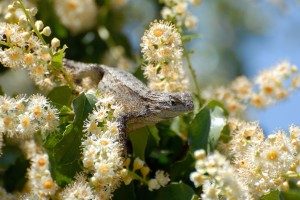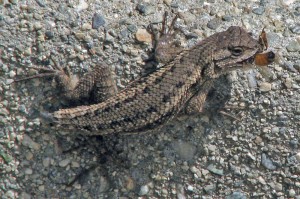While on a photography expedition last Saturday, Jonathan Wright, Harsi Parker, and I spotted a Red Admiral, Vanessa atalanta, flitting by a Holly-leafed Cherry (Prunus ilicifolia) in full bloom on the south shore of pHake Lake. Just as I was getting the butterfly in focus, something lunged out of shrub at the butterfly — a Western Fence Lizard (Sceloporus occidentalis)! The butterfly escaped, but we realized the lizard was just lurking up there among the blossoms picking off honeybees!
Now how can a Sceloporus eat bees without being stung? Is it resistant to bee venom? A quick search in the scientific literature failed to provide an answer, but I found this fascinating account in Gleanings in Bee Culture, Vol. 32 (1904), entitled “Do California lizards kill bees?”:
While eating at my luncheon in the shack at the apiary I noticed, when I commenced, several bees buzzing on the window; also that a lizard was scurrying about inside the shade. In the course of a short time I observed that there was but one bee left, and came to the conclusion that the various scurries I had heard had meant that each denoted the end of a bee, so I determined to pay particular attention to what became of this last one. After a short wait I heard another scramble, and the buzz of the last bee had ceased. Gently raising and looking under the shade I saw the lizard with the bee in its mouth. It was holding the head and body, up to the thorax, in its mouth, with the abdomen out, under side up, the bee vainly thrusting its sting in the air. While watching, it began a series of quick side rubs on the curtain until it eventually severed the abdomen, which fell to the floor, while it swallowed the portion held in its mouth.
The author, E.W. Moore, of Los Angeles, also notes that inside a hive he found a dead lizard with many stings in its body, and he concludes that lizards are susceptible to bee venom.
So it appears that lizards avoid bee stings by cunning, not chemistry!
Update: On reading this post, Harsi Parker realized that she had a photo of a Sceloporus with a bee in its mouth with the abdomen out, just as described by Moore!
Although this lizard may be smart about bees, it seems it failed to avoid some predator, who got the lizard’s tail.

